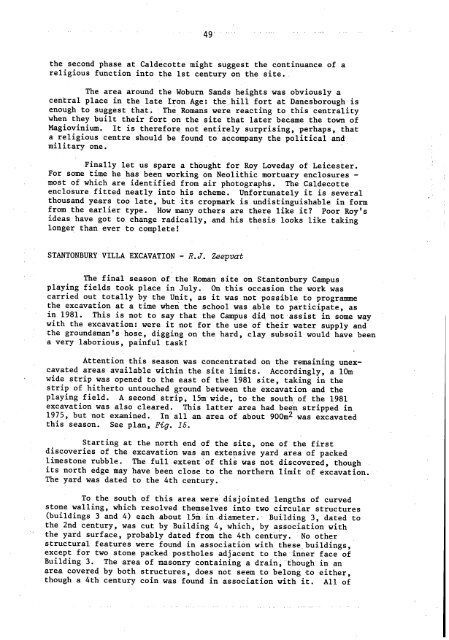CBA SMA\SMA 1983.PDF - Council for British Archaeology
CBA SMA\SMA 1983.PDF - Council for British Archaeology
CBA SMA\SMA 1983.PDF - Council for British Archaeology
Create successful ePaper yourself
Turn your PDF publications into a flip-book with our unique Google optimized e-Paper software.
49"<br />
the second phase at Caldecotte might suggest the continuance of a<br />
religious function into the 1st century on the site.<br />
The area around the Woburn Sands heights was obviously a<br />
central place in the late Iron Age: the hill <strong>for</strong>t at Danesborough is<br />
enough to suggest that. The Romans were reacting to this centrality<br />
when they built their <strong>for</strong>t on the site that later became the town of<br />
Magiovinium. It is there<strong>for</strong>e not entirely surprising, perhaps, that<br />
a religious centre should be found to accompany the political and<br />
military one.<br />
Finally let us spare a thought <strong>for</strong> Roy Loveday of Leicester.<br />
For some time he has been working on Neolithic mortuary enclosures -<br />
most of which are identified from air photographs. The Caldecotte<br />
enclosure fitted neatly into his scheme. Un<strong>for</strong>tunately it is several<br />
thousand years too late, but its cropmark is undistinguishable in <strong>for</strong>m<br />
from the earlier type. How many others are there like it? Poor Roy's<br />
ideas have got to change radically, and his thesis looks like taking<br />
longer than ever to complete!<br />
STANTONBURY VILLA EXCAVATION - R.J. Zeepvat<br />
The final season of the Roman site on Stantonbury Campus<br />
playing fields took place in July. On this occasion the work was<br />
carried out totally by the Unit, as it was not possible to programme<br />
the excavation at a time when the school was able to participate, as<br />
in 1981. This is not to say that the Campus did not assist in some way<br />
with the excavation: were it not <strong>for</strong> the use of their water supply and<br />
the groundsman's hose, digging on the hard, clay subsoil would have been<br />
a very laborious, painful task!<br />
Attention this season was concentrated on the remaining unexcavated<br />
areas available within the site limits. Accordingly, a 10m<br />
wide strip was opened to the east of the 1981 site, taking in the<br />
strip of hitherto untouched ground between the excavation and the<br />
playing field. A second strip, 15m wide, to the south of the 1981<br />
excavation was also cleared. This latter area had been stripped in<br />
1975, but not examined. In all an area of about 900m2 was excavated<br />
this season. See plan, Fig. 15.<br />
Starting at the north end of the site, one of the first<br />
discoveries of the excavation was an extensive yard area of packed<br />
limestone rubble. The full extent of this was not discovered, though<br />
its north edge may have been close to the northern limit of excavation.<br />
The yard was dated to the 4th century.<br />
To the south of this area were disjointed lengths of curved<br />
stone walling, which resolved themselves into two circular structures<br />
(buildings 3 and 4) each about 15m in diameter. Building 3, dated to<br />
the 2nd century, was cut by Building 4, which, by association with<br />
the yard surface, probably dated from the 4th century. No other<br />
structural features were found in association with these buildings,<br />
except <strong>for</strong> two stone packed postholes adjacent to the inner face of<br />
Building 3. The area of masonry containing a drain, though in an<br />
area covered by both structures, does not seem to belong to either,<br />
though a 4th century coin was found in association with it. All of

















